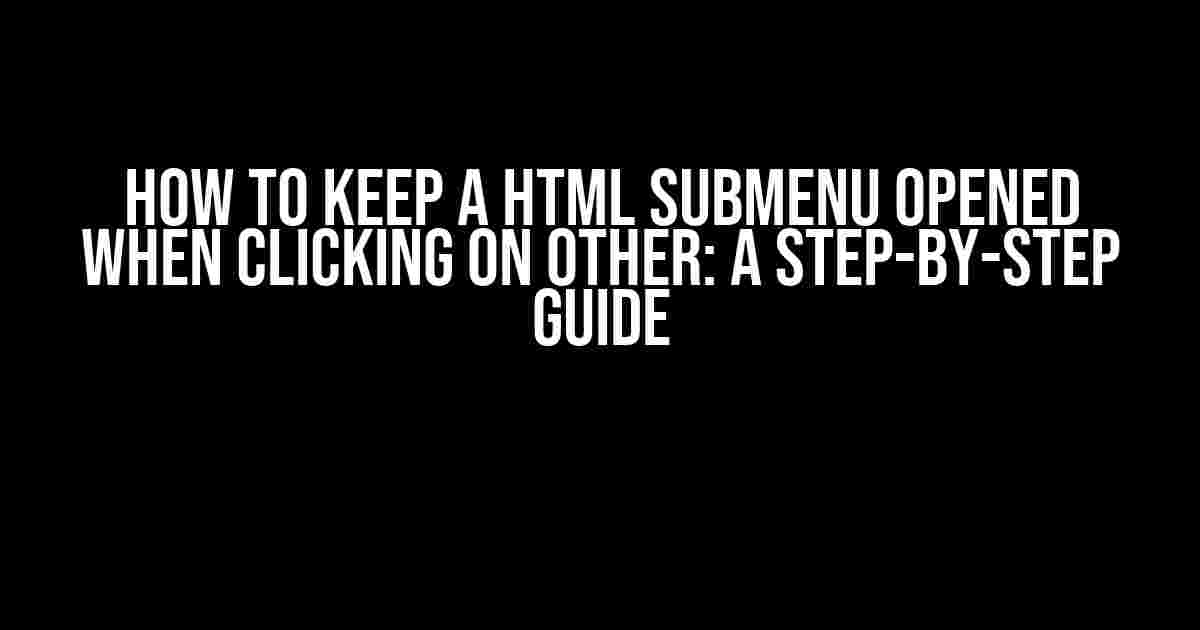Are you tired of dealing with pesky submenus that disappear the moment you click somewhere else on the page? Do you want to provide a seamless user experience for your website visitors? Look no further! In this comprehensive guide, we’ll show you how to keep your HTML submenu opened when clicking on other elements.
Understanding the Problem: Why Submenus Close Automatically
By default, HTML submenus are designed to close when you click anywhere outside the menu or submenu. This is because the HTML specification defines the `
- ` and `
- ` elements as containing only inline elements. When you click outside the submenu, the browser assumes you want to focus on another part of the page, and the submenu gets closed.
The Solution: Using JavaScript and CSS to Keep the Submenu Open
To keep the submenu open, we’ll need to use JavaScript and CSS to override the default behavior. We’ll create a script that listens for clicks on the submenu and prevents the browser from closing it. We’ll also add some CSS to style our submenu and make it look visually appealing.
Step 1: Creating the HTML Structure
First, let’s create the basic HTML structure for our menu and submenu. We’ll use the `
- ` and `
- ` elements to define our menu items.
<ul id="main-menu"> <li><a href="#">Menu Item 1</a></li> <li><a href="#">Menu Item 2</a> <ul id="submenu"> <li><a href="#">Submenu Item 1</a></li> <li><a href="#">Submenu Item 2</a></li> </ul> </li> <li><a href="#">Menu Item 3</a></li> </ul>Step 2: Adding the CSS Styles
Next, let’s add some CSS styles to make our submenu look visually appealing. We’ll use the `:hover` pseudo-class to style the submenu when it’s hovered over.
#submenu { position: absolute; display: none; background-color: #f0f0f0; border: 1px solid #ccc; padding: 10px; } #submenu li { margin-bottom: 10px; } #submenu li a { text-decoration: none; color: #333; } #submenu li a:hover { color: #666; } #main-menu li:hover #submenu { display: block; }Step 3: Adding the JavaScript Code
Now, let’s add the JavaScript code that will keep our submenu open when we click on other elements. We’ll use the `addEventListener` method to listen for clicks on the submenu and prevent the browser from closing it.
<script> const submenu = document.getElementById('submenu'); submenu.addEventListener('click', function(event) { event.stopPropagation(); }); document.addEventListener('click', function(event) { if (!submenu.contains(event.target)) { submenu.style.display = 'none'; } }); </script>How the Code Works
The JavaScript code works by adding an event listener to the submenu that listens for clicks. When a click event occurs, the `stopPropagation` method prevents the browser from closing the submenu.
The code also adds an event listener to the entire document that listens for clicks. When a click event occurs outside the submenu, the code checks if the target element is not a descendant of the submenu using the `contains` method. If it’s not, the code sets the `display` property of the submenu to `none`, effectively closing it.
Step 4: Putting it All Together
Let’s put all the code together and see our submenu in action!
<ul id="main-menu"> <li><a href="#">Menu Item 1</a></li> <li><a href="#">Menu Item 2</a> <ul id="submenu"> <li><a href="#">Submenu Item 1</a></li> <li><a href="#">Submenu Item 2</a></li> </ul> </li> <li><a href="#">Menu Item 3</a></li> </ul> <style> #submenu { position: absolute; display: none; background-color: #f0f0f0; border: 1px solid #ccc; padding: 10px; } #submenu li { margin-bottom: 10px; } #submenu li a { text-decoration: none; color: #333; } #submenu li a:hover { color: #666; } #main-menu li:hover #submenu { display: block; } </style> <script> const submenu = document.getElementById('submenu'); submenu.addEventListener('click', function(event) { event.stopPropagation(); }); document.addEventListener('click', function(event) { if (!submenu.contains(event.target)) { submenu.style.display = 'none'; } }); </script>Common Issues and Solutions
Here are some common issues you might encounter when implementing this code:
Issue Solution Submenu doesn’t stay open when clicking on a link Make sure the link has a `href` attribute set to `#` or a valid URL. Also, ensure that the JavaScript code is executed after the DOM has loaded. Submenu stays open when clicking on another menu item Add a click event listener to the menu items that closes the submenu when another menu item is clicked. Submenu doesn’t close when clicking outside the menu Make sure the JavaScript code is adding the event listener to the document element correctly. Also, ensure that the `contains` method is checking the correct element. Conclusion
In this comprehensive guide, we’ve shown you how to keep a HTML submenu opened when clicking on other elements. By using JavaScript and CSS, we’ve created a seamless user experience for our website visitors. Remember to test your code thoroughly and troubleshoot any issues that arise.
With this knowledge, you can take your website’s navigation to the next level and provide a better user experience for your visitors. Happy coding!
Here are the 5 Questions and Answers about “How to keep a HTML Submenu Opened When Clicking on Other” in HTML format:
Frequently Asked Question
Get the solutions to your most pressing questions about keeping HTML submenus opened when clicking on other elements!
How do I keep a HTML submenu open when I click on another menu item?
You can achieve this by adding a `click` event listener to the parent menu item that toggles the submenu’s visibility. Use JavaScript to add a class to the submenu when the parent item is clicked, and then use CSS to style the submenu accordingly.
What is the best approach to keep the submenu open when clicking on a link within the submenu itself?
One way to do this is to add a `preventDefault()` method to the link’s `click` event, which prevents the default link behavior from occurring. You can then add a script that toggles the submenu’s visibility programmatically.
Can I use CSS alone to keep the submenu open when clicking on another menu item?
Unfortunately, no. CSS alone cannot achieve this behavior, as it does not have the capability to respond to user interactions like clicking. You’ll need to use JavaScript to add event listeners and toggle the submenu’s visibility.
How do I keep the submenu open when clicking on a button or form submission within the submenu?
In this case, you’ll need to add a `preventDefault()` method to the button or form’s `click` event, and then use JavaScript to toggle the submenu’s visibility programmatically. You may also need to add additional logic to handle the form submission or button click.
Are there any specific considerations I should keep in mind when implementing this behavior for mobile devices?
Yes! When implementing this behavior for mobile devices, you’ll need to consider the smaller screen size and touch-based interactions. You may need to add additional JavaScript logic to handle touch events and ensure the submenu remains open when clicked. Additionally, consider using a mobile-friendly UI/UX design to enhance the user experience.
I hope this helps!
- ` elements to define our menu items.



